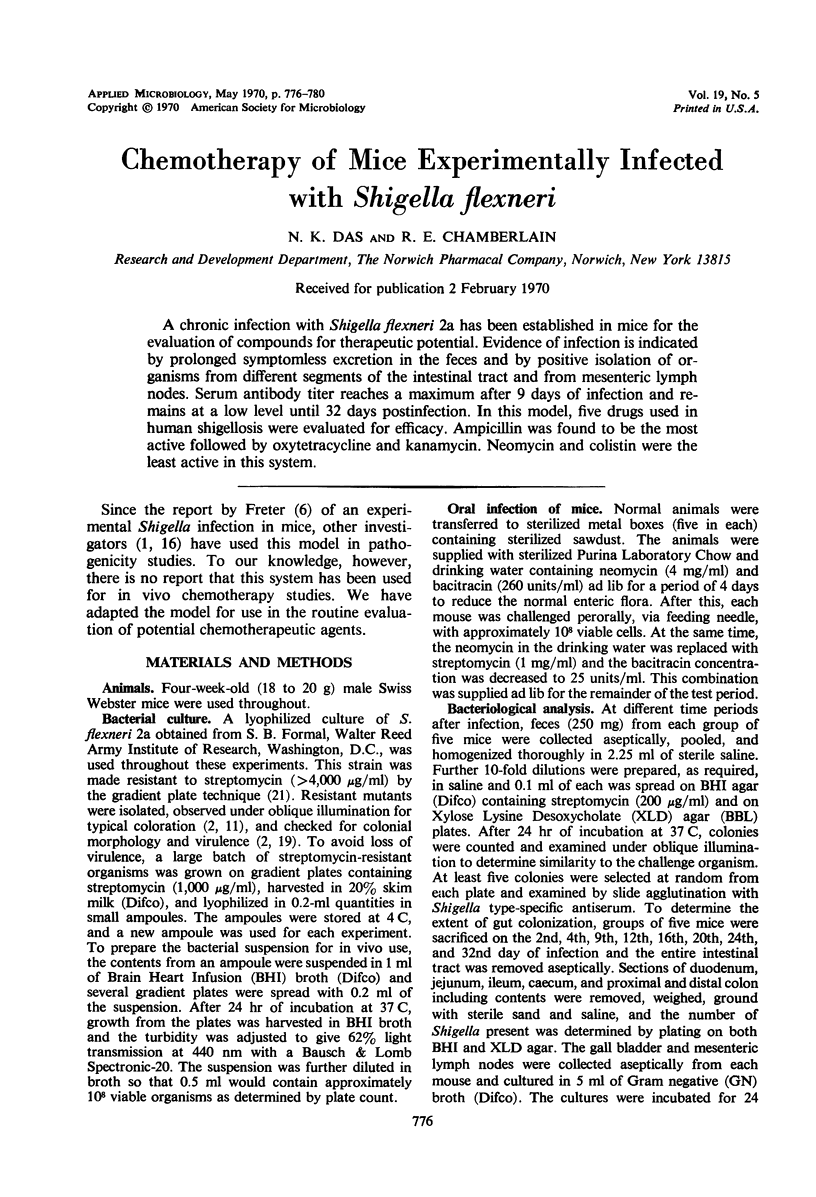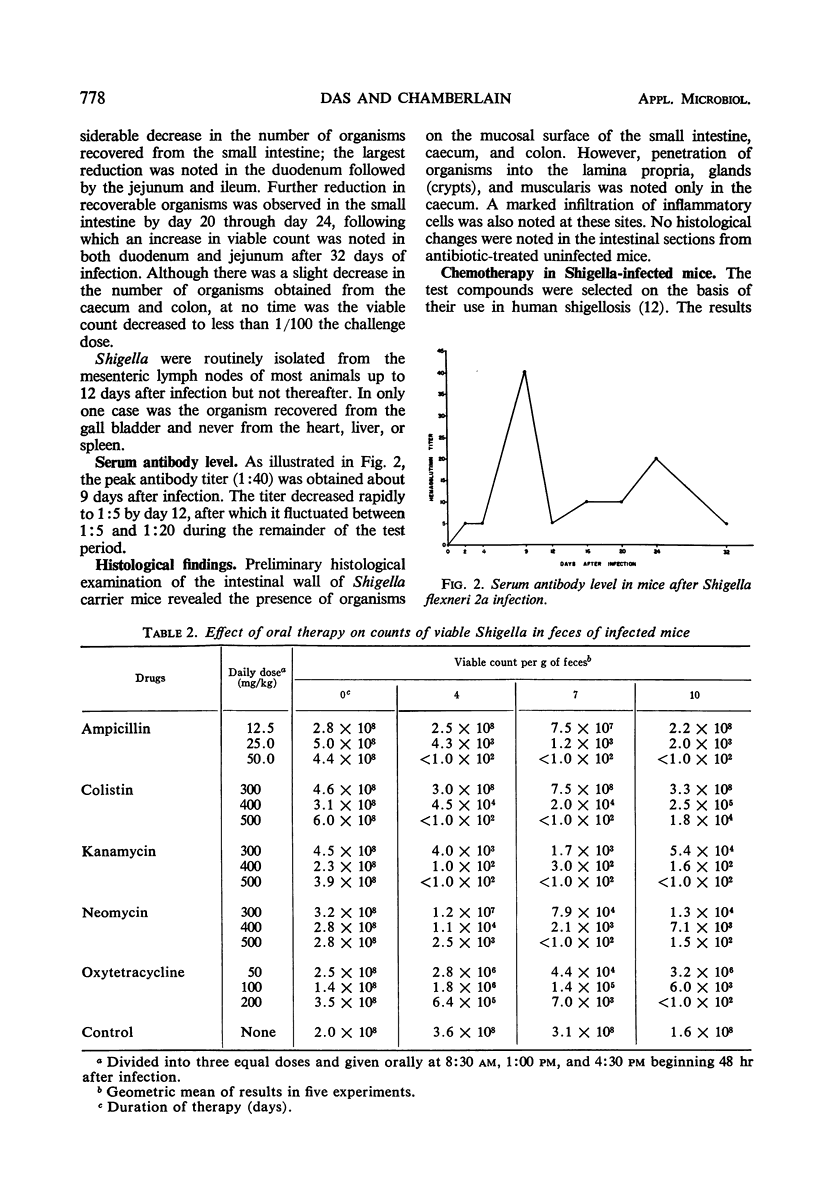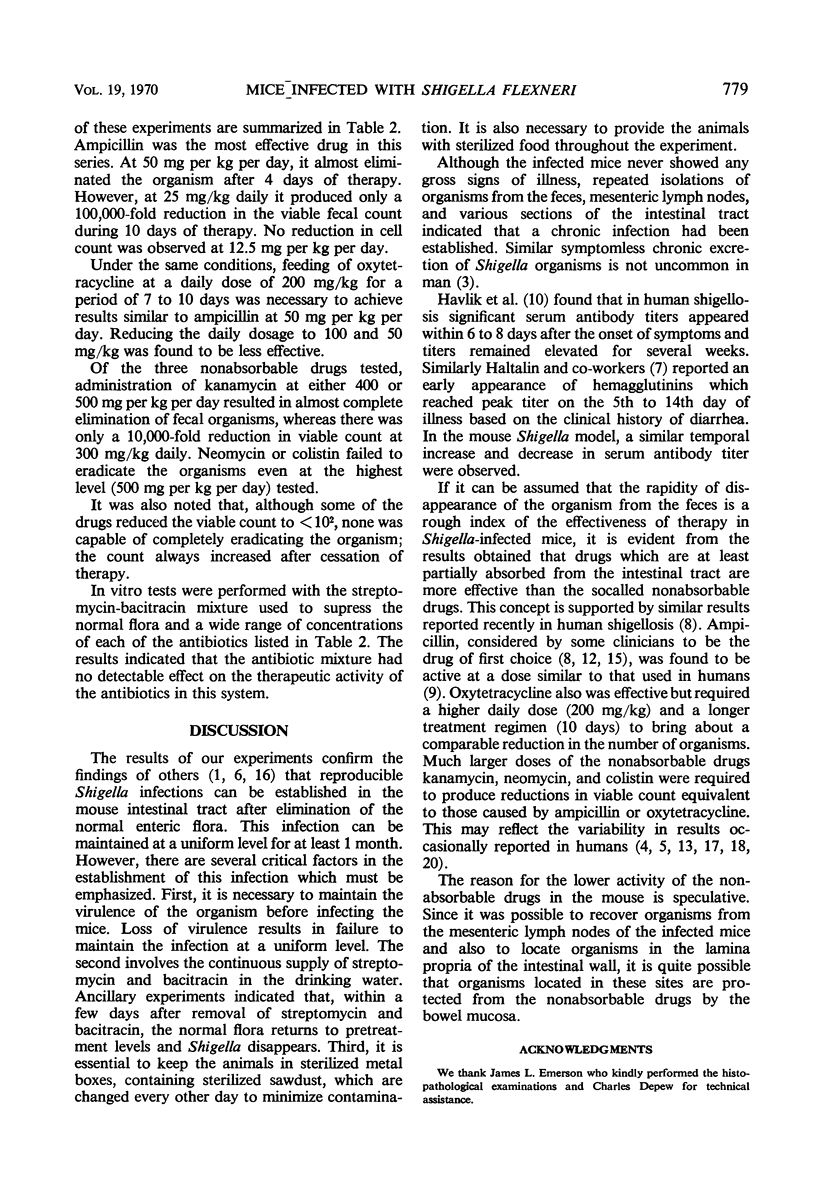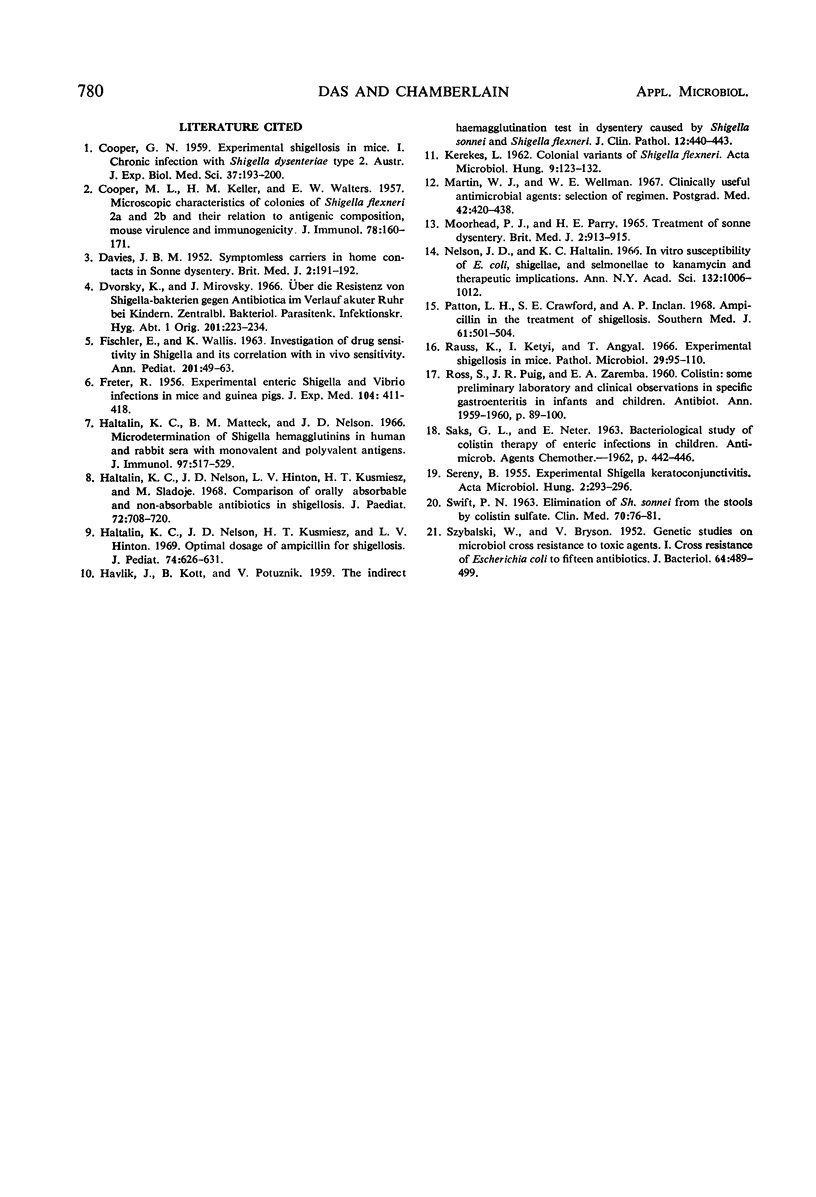Abstract
A chronic infection with Shigella flexneri 2a has been established in mice for the evaluation of compounds for therapeutic potential. Evidence of infection is indicated by prolonged symptomless excretion in the feces and by positive isolation of organisms from different segments of the intestinal tract and from mesenteric lymph nodes. Serum antibody titer reaches a maximum after 9 days of infection and remains at a low level until 32 days postinfection. In this model, five drugs used in human shigellosis were evaluated for efficacy. Ampicillin was found to be the most active followed by oxytetracycline and kanamycin. Neomycin and colistin were the least active in this system.
Full text
PDF




Selected References
These references are in PubMed. This may not be the complete list of references from this article.
- COOPER G. N. Experimental shigellosis in mice. I. Chronic infection with Shigella dysenteriae type 2. Aust J Exp Biol Med Sci. 1959 Jun;37:193–200. doi: 10.1038/icb.1959.21. [DOI] [PubMed] [Google Scholar]
- COOPER M. L., KELLER H. M., WALTERS E. W. Microscopic characteristics of colonies of Shigella flexneri 2a and 2b and their relation to antigenic composition, mouse virulence and immunogenicity. J Immunol. 1957 Mar;78(3):160–171. [PubMed] [Google Scholar]
- Clinically useful antimicrobial agents. Selection of regimen. Postgrad Med. 1967 Nov;42(5):420–433. [PubMed] [Google Scholar]
- DAVIES J. B. M. Symptomless carriers in home contacts in Sonne dysentery. Br Med J. 1952 Jul 26;2(4777):191–192. doi: 10.1136/bmj.2.4777.191. [DOI] [PMC free article] [PubMed] [Google Scholar]
- Dvorský K., Mirovský J. Uber die Resistenz von Shigellabakterien gegen Antibiotica im Verlauf akuter Ruhr bei Kindern. Zentralbl Bakteriol Orig. 1966 Oct;201(2):223–234. [PubMed] [Google Scholar]
- FISCHLER E., WALLIS K. INVESTIGATION OF DRUG SENSITIVITY IN SHIGELLA AND ITS CORRELATION WITH "IN VIVO" SENSITIVITY. Ann Paediatr. 1963;201:49–63. [PubMed] [Google Scholar]
- FRETER R. Experimental enteric Shigella and Vibrio infections in mice and guinea pigs. J Exp Med. 1956 Sep 1;104(3):411–418. doi: 10.1084/jem.104.3.411. [DOI] [PMC free article] [PubMed] [Google Scholar]
- HAVLIK J., KOTT B., POTUZNIK V. The indirect haemagglutination test in dysentery caused by Shigella sonnei and Shigella flexneri. J Clin Pathol. 1959 Sep;12:440–443. doi: 10.1136/jcp.12.5.440. [DOI] [PMC free article] [PubMed] [Google Scholar]
- Haltalin K. C., Matteck B. M., Nelson J. D. Microdetermination of Shigella hemagglutinins in human and rabbit sera with monovalent and polyvalent antigens. J Immunol. 1966 Oct;97(4):517–524. [PubMed] [Google Scholar]
- Haltalin K. C., Nelson J. D., Hinton L. V., Kusmiesz H. T., Sladoje M. Comparison of orally absorbable and nonabsorbable antibiotics in shigellosis. A double-blind study with ampicillin and neomycin. J Pediatr. 1968 May;72(5):708–720. doi: 10.1016/s0022-3476(68)80021-6. [DOI] [PubMed] [Google Scholar]
- Haltalin K. C., Nelson J. D., Kusmiesz H. T., Hinton L. V. Optimal dosage of ampicillin for shigellosis. J Pediatr. 1969 Apr;74(4):626–631. doi: 10.1016/s0022-3476(69)80051-x. [DOI] [PubMed] [Google Scholar]
- KEREKES L. Colonial variants of Shigella flexneri. Acta Microbiol Acad Sci Hung. 1962;9:123–132. [PubMed] [Google Scholar]
- Moorhead P. J., Parry H. E. Treatment of sonne dysentery. Br Med J. 1965 Oct 16;2(5467):913–915. doi: 10.1136/bmj.2.5467.913. [DOI] [PMC free article] [PubMed] [Google Scholar]
- Nelson J. D., Haltalin K. C. In-vitro susceptibility of E. coli, Shigellae and Salmonellae to kanamycin and therapeutic implications. Ann N Y Acad Sci. 1966 Jun 14;132(2):1006–1012. doi: 10.1111/j.1749-6632.1966.tb43025.x. [DOI] [PubMed] [Google Scholar]
- Patton L. H., Crawford S. E., Inclan A. P. Ampicillin inthe treatment of shigellosis. South Med J. 1968 May;61(5):501–504. doi: 10.1097/00007611-196805000-00012. [DOI] [PubMed] [Google Scholar]
- ROSS S., PUIG J. R., ZAREMBA E. A. Colistin: some preliminary laboratory and clinical observations in specific gastroenteritis in infants and children. Antibiot Annu. 1959;7:89–100. [PubMed] [Google Scholar]
- Rauss K., Kétyi I., Angyal T. Experimental shigellosis in mice. Pathol Microbiol (Basel) 1966;29(1):95–110. doi: 10.1159/000161890. [DOI] [PubMed] [Google Scholar]
- SERENY B. Experimental shigella keratoconjunctivitis; a preliminary report. Acta Microbiol Acad Sci Hung. 1955;2(3):293–296. [PubMed] [Google Scholar]
- SWIFT P. N. Elimination of Sh. sonnei from the stools by colistin sulphate. Clin Med (Northfield) 1963 Jan;70:76–81. [PubMed] [Google Scholar]
- SZYBALSKI W., BRYSON V. Genetic studies on microbial cross resistance to toxic agents. I. Cross resistance of Escherichia coli to fifteen antibiotics. J Bacteriol. 1952 Oct;64(4):489–499. doi: 10.1128/jb.64.4.489-499.1952. [DOI] [PMC free article] [PubMed] [Google Scholar]


